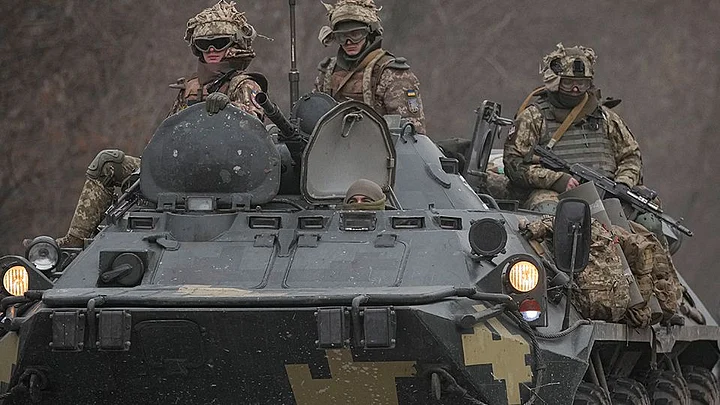One of the features of modern warfare is the role played by non-state militias, and Ukraine is no exception. Reporting of the war has highlighted the role of the Wagner Group on the Russian side, for instance.
This 6,000 strong mercenary force, which is usually based in Africa and recently saw action in the Sahel, is believed to be funded by Yevgeny Prigozhin, a businessman with close links to Vladimir Putin.
About 1,000 Wagner Group fighters have been drafted in as part of the invasion. It was reported at the end of March that members of the group had been tasked with finding and assassinating the Ukrainian president, Volodymyr Zelenskyy.
Alongside the Wagner Group, Moscow has also drafted in militia volunteers from both Chechnya and Syria to reinforce the Russian army ahead of assaults on key strategic areas in Ukraine.
On the other side, Ukraine has relied heavily upon established militias such as the Azov Battalion, as well as newly formed civilian militias, to repel Russian armed forces.
Militias are armed non-state groups that are usually recruited from the civilian population to support state security forces, primarily during times of emergency.
These para-militarised, quasi-institutional groups strengthen both the quantity – and sometimes the quality – of the state’s military capability.
Governments often contract militia groups to conduct operations against armed rebel organisations during counterinsurgency warfare. In Colombia, the Bogota government enlisted the support of right-wing paramilitary groups – often trained by the US – in its war against Farc and other left-wing insurgent groups. Militias have also been used by governments as a protector against internal threats, such as threats of coups from other state actors, including the military.
Depending on how close the militia is to the government, the state may provide weapons, resources, training and intelligence to the group. In other cases, a state will delegate power to a militia to conduct military operations on its behalf.
Russia’s Proxy Fighters
Militias have also often been used by states in inter-state warfare, so their use in the war in Ukraine is unsurprising. What is surprising is the role these militias are playing in the conflict. Militias deployed by Russia are tightly controlled, recruited, directed and resourced by Russia’s government and armed forces.
On the Ukrainian side, the state-militia relationship is more ambiguous and fluid, with the Kyiv government not always securing direct control over pro-Ukrainian militias that can be deemed semi-independent or independent armed actors.
In early March, it emerged that Russia had contracted the Chechen Kadyrov militia to conduct specific operations in Ukraine, including a plot to kill President Zelensky. The deployment of the militia by Russia was also viewed as a form of psychological warfare in that it was designed to instil fear and terror into the minds of both the Ukrainian armed forces and the civilian population, given the brutality associated with the Kadyrov militia in past conflicts. Russian forces have also begun recruiting volunteers from pro-Assad militias involved in the Syrian civil war. It is believed these militias are already in Russia awaiting deployment to Ukraine.
As for the Wagner Group – unlike other militias deployed by Russia – it has been heavily involved in pursuing Russia’s foreign policy objectives in both Africa and the Middle East, and with proficiency and tactical efficiency. The group is highly professional and operates almost like a special forces organisation.
Pro-Ukrainian Militias
Pro-Ukrainian militias, meanwhile, tend to be more autonomous than their Russian counterparts, and have successfully used guerrilla-style tactics to repel vastly superior Russian tank and troop columns.
The Azov Battalion is the most prominent of Ukraine’s non-state militias. It has cooperated with the official Ukrainian armed forces and has been partly co-opted into the national guard, albeit it has retained its identity and semi-autonomous independence. The militia was formed in 2014 in response to pro-Russian separatist rebels operating in the Donbas region of eastern Ukraine. It is believed to be a far-right organisation that emerged from a far-right political movement, Svoboda, designed to promote white nationalist, anti-immigrant politics.
A vast array of other smaller, pro-Ukrainian militias are also engaged in combat against Russian ground forces, including the Dnipro Battalion, funded by Ukranian banking tycoon, Ihor Kolomoisky.
Meanwhile, the Ukrainian government has armed large sections of the civilian population, in effect creating a mass-mobilised pro-government militia. These citizens have also engaged Russian units in hit-and-run attacks with small arms and Molotov cocktails.
The civilian militia has helped in preparing urban defences in Ukrainian cities against possible Russian advances.
The fighting looks set to shift towards the eastern regions of Ukraine, after the failure of Russian forces to take Kyiv in the first part of the war. The Donbas has been a focus for fighting by pro-Russian separatists since 2014 and has the biggest concentration of Russian speakers.
If the conflict shifts eastwards towards the Donbas region, then so too will the militias already embroiled in the conflict. Human rights abuses have been committed by militias here in the past. Away from the urban centres of Kyiv and Kharkiv, oversight of these militias by regular armed forces on both sides may become more limited.
(This is an opinion piece and the views expressed above are the author’s own. The Quint neither endorses nor is responsible for the same. This article was originally published on The Conversation. Read the original article here.)
